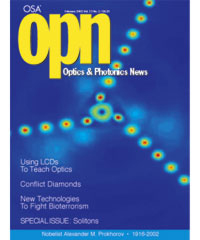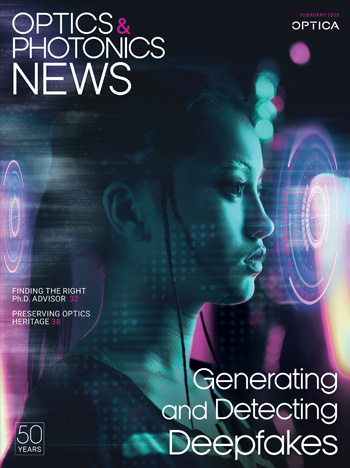
February 2002 Issue
- Conflict Diamonds
- From the Guest Editor--Solitons: A Universal Phenomenon of Self-Trapped Wave Packets
- Incoherent Solitons
- Optical Technologies in the Fight Against Bioterrorism
- Spatial Optical Solitons
- Spatiotemporal Solitons
- Optical Solitons in Fibers for Communication Systems
- Photorefractive Solitons
- Quadratic Solitons
- Discrete Solitons
- Cavity and Feedback Solitons
- Entangling Fiber Solitons: Quantum Noise Engineering for Interferometry and Communication
- Browse all Issues
Feature Articles
Conflict Diamonds
Scientists and law enforcement officials are hoping that optics-based applications may one day help staunch the flow of “blood diamonds.” Also known as conflict diamonds or rough diamonds, blood diamonds are contraband gems from Africa. After being mined or plundered by rebel groups, the diamonds are sold on the black market to finance the purchase of arms. Traditionally linked to rebel uprisings in countries including Angola, the Congo, and Sierra Leone, today the blood diamond trade is also said to be fueling the operations of the al Qaeda terrorist network, believed responsible for the September 11 attacks.
by Suz RedfearnFrom the Guest Editor--Solitons: A Universal Phenomenon of Self-Trapped Wave Packets
More than 150 years have passed since solitons were first observed by J.S. Russell in the water of a shallow canal in Scotland. In this issue of OPN, we have worked to bring together an engaging collection of review articles on optical solitons and to provide the optics community with a glimpse of the most exciting highlights of optical soliton research.
by Mordechai SegevIncoherent Solitons
Solitons are fascinating entities that are known to exist in many different branches of physics. They represent self-localized wave packets that do not expand while propagating in a dispersive environment. The localization (self-trapping) relies on a nonlinear effect, and it can result from a variety of nonlinear mechanisms. In general, solitons exhibit a rich, particlelike behavior that is clearly manifested during their interactions (collisions). Despite their diversity, solitons are a universal phenomenon and thus share many common features. In their most frequent realization, these particlelike wave packets are fully coherent entities. In this case, given the soliton phase at a particular location as well as the frequency of the carrier wave, one can deterministically predict the phase everywhere (at any given point in space and time) upon the soliton.
by Mordechai Segev and Demetrios N. ChristodoulidesOptical Technologies in the Fight Against Bioterrorism
Optical technologies that can detect or destroy biological agents could play a major role in protecting communities from bioterrorist attacks such as the anthrax mailings that killed five people and infected dozens more in the U.S. this past autumn. Devices that improve response capability to biological attacks are crucial to minimizing the threat because of the lag time between exposure to the biological agent and the appearance of symptoms. Fixed and portable optical sensors that identify biological organisms in minutes are available. Sensor technology, coupled with new germicidal irradiation techniques that instantaneously eradicate bacteria spores, could help minimize human casualties in the event of future attacks.
by Tyler KrupaSpatial Optical Solitons
Spatial optical solitons may provide a powerful means for creating reconfigurable, all-optical circuits in which light is guided and controlled by light. We present a panoramic overview of the basic properties of optical solitons, emphasizing a variety of their characteristics and manifestations, and speculating on possible future developments and applications.
by Yuri S. Kivshar and George I. StegemanSpatiotemporal Solitons
The possibility of creating and observing spatiotemporal solitons--pulses of light that do not spread in time or space--has fascinated researchers for years. The issues involved in the production of such pulses, and recent progress toward their experimental realization, are reviewed.
by Frank Wise and Paolo Di TrapaniOptical Solitons in Fibers for Communication Systems
Solitons of light-wave envelopes in fibers, now commonly called optical solitons, were among the first solitons to be discovered. The existence of optical solitons was predicted in 1973 and confirmed by experiment in 1980. In the intervening twenty years, attempts to employ optical solitons in ultrahigh-speed communication systems have been rendered difficult by the fact that public demand for higher speed and longer distance transmission have grown at an unexpectedly rapid rate.
by Akira HasegawaPhotorefractive Solitons
The story has it that, when Schwinger learned of the Feynman diagrams, he remarked that quantum electrodynamics had been brought to the masses. A similar statement could be applied to photorefractive (PR) solitons. In fact, among the family of known optical self-trapped waves, PR solitons are of an altogether peculiar nature: they are the consequence of an extended buildup in time of optical nonlinearity. As a consequence, although the generation of a spatial soliton in conventional nonlinear media requires the use of high optical powers and sophisticated experimental techniques, its observation in PR media requires a few milliwatts of continuous-wave laser power and accessible experimental apparatus. In other words, the discovery that PR crystals support spatial nonlinear waves has profoundly altered the rules of the game and has rapidly shifted attention from soliton generation physics to the rich realm of soliton phenomenology. This circumstance has produced the involvement of a relatively large number of experimental groups, making the topic a field in its own right.
by Bruno Crosignani and Greg SalamoQuadratic Solitons
The experimental demonstration in 1995 of spatial soliton formation mediated by parametric wave interactions in crystals with quadratic nonlinearities, which had been theoretically predicted in the 1970s, opened a range of exciting new opportunities in the field of soliton science and its applications. For many years, second-order (or quadratic) nonlinearities had been associated only with the frequency conversion of laser light. A crucial step towards richer opportunities was the emergence of cascading, where cross-induced energy- and phase-shifts acquired by multiple light waves that parametrically interact in a material with a quadratic nonlinearity are exploited to perform all-optical operations on signals. To form a soliton, or in other words a self-sustained, localized, non-spreading light packet, such energy- and phase-shifts can also be used to dynamically counteract spreading caused by diffraction and by group-velocity dispersion.
by Lluis Torner and Anatoly P. SukhorukovDiscrete Solitons
Optics deals with continuous objects: The electromagnetic fields are continuous functions of space and time. There are situations, however, in which the evolution of an optical field can be represented as a discrete problem. This happens when the field can be described as a sum of discrete modes. One such simple and important case is that of a coupled one-dimensional (1D) waveguide array. In a waveguide array, a large number (infinite in principle) of single-mode channel waveguides are laid one near the other such that their individual modes overlap. The evolution of the transversal field distribution is described by an infinite sum of coupled complex amplitudes of the individual modes. The problem of light propagation in a linear array was first treated theoretically by Jones, and later studied by Yariv and co-workers, who fabricated and tested such arrays in gallium arsenide.
by Falk Lederer and Yaron SilberbergCavity and Feedback Solitons
"Catch a soliton and put it in your pocket...save it for a rainy day." While this may represent a bit of wishful thinking, cavity solitons are a very interesting kind of "stopped light."
by William J. Firth and Carl O.WeissEntangling Fiber Solitons: Quantum Noise Engineering for Interferometry and Communication
Many particle systems follow a complex time evolution. If system interactions are governed by nonlinear behavior, the theoretical description is often difficult to address. The nonlinear dynamics of some systems feature solitary waves or solitons, which are dynamically stable excitations. They come about whenever the ubiquitous dispersion of a wave is compensated for by some nonlinear, i.e., amplitude-dependent response. First observed in water, today solitons are known to appear in many systems in different fields of physics.
by Gerd Leuchs and Natalia KorolkovaDepartments and Columns
Antitrust and Intellectual Property
In this month’s column we will focus on antitrust issues related to intellectual property.
Conflicted Congress of Two Minds on Dual-Use Exports
While the search for legislative responses to terrorism continues in the 2002 congressional session, a new set of issues unrelated to the September 11 attacks will come to the fore. One which affects high-technology industries, including optics, is reform of the U.S. export control system.
A New "Twist" on Optics Education
In addition to the major role liquid crystal displays (LCDs) play in our “portable” lives, these high-tech devices possess remarkable value from an educational point of view.
Starting (and Managing) a Career in a Volatile Market
Today’s optics students are offered a number of exciting career possibilities, some of them non-traditional. How can you prepare for an optics career in an uncertain world?
ADVERTISEMENT
ADVERTISEMENT
Also in this Issue
From the President
Book Reviews
OSA Homepage
Recent Research
Atom Optics with Giant Quantum Reflection From a Solid Surface, Absolute Testing of Cylindrical Surfaces with Grazing Incidence Interferometry, Operation of a I-W Single-Mode External-Cavity Laser-Diode Array Near 780nm, Scalable Multispectral Semiconductor-Laser Sensing System Using Orthogonal Code-Division Multiplexing, Nonlinear Microstructured Glass Fibers for Optical Signal Processing, Decoherence Effects in Practical Quantum Cryptography Key Distribution Based on Polarization-Entangled Photons, Axial Irradiance throughout the Whole Space behind an Annular Aperature, Optical Microrheology in Localized Coherence Volumes
After Image
Brilliant Auroral Display
OSA 2001 Contributors
OSA is pleased to recognize the generous contributions of a number of individual members, corporations, government agencies, and entities. OSA greatly appreciates their support.

![Illustration of a synapse in the brain. [Getty Images]](https://opnmedia.blob.core.windows.net/$web/opn/media/images/articles/2025/0425/departments/202504-cover-web.jpg?ext=.jpg)
![Fiber draped around a hand, demonstrating its flexibility. [Photo by Z. Wang and L. Wei]](https://opnmedia.blob.core.windows.net/$web/opn/media/images/articles/2025/0325/departments/202503-cover-web.jpg?ext=.jpg)
